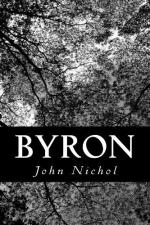O had my fate been join’d with thine.
In the following year he accepted an invitation to dine at Annesley, and was visibly affected by the sight of the infant daughter of Mrs. Chaworth, to whom he addressed a touching congratulation. Shortly afterwards, when about to leave England for the first time, he finally addressed her in the stanzas,—
’Tis done, and shivering in the
gale,
The bark unfurls her snowy sail.
Some years later, having an opportunity of revisiting the family of his successful rival, Mrs. Leigh dissuaded him. “Don’t go,” she said, “for if you do you will certainly fall in love again, and there will be a scene.” The romance of the story culminates in the famous Dream, a poem of unequal merit, but containing passages of real pathos, written in the year 1816 at Diodati, as we are told, amid a flood of tears.
Miss Chaworth’s attractions, beyond those of personal beauty, seem to have been mainly due—a common occurrence—to the poet’s imagination. A young lady, two years his senior, of a lively and volatile temper, she enjoyed the stolen interviews at the gate between the grounds, and laughed at the ardent letters, passed through a confidant, of the still awkward youth whom she regarded as a boy. She had no intuition to divine the presence, or appreciate the worship, of one of the future master-minds of England, nor any ambition to ally herself with the wild race of Newstead, and preferred her hale, commonplace, fox-hunting squire. “She was the beau ideal,” says Byron, in his first accurate prose account of the affair, written 1823, a few days before his departure for Greece, “of all that my youthful fancy could paint of beautiful. And I have taken all my fables about the celestial nature of women from the perfection my imagination created in her. I say created; for I found her, like the rest of the sex, anything but angelic.”
Mrs. Musters (her husband re-asserted his right to his own name) had in the long-run reason to regret her choice. The ill-assorted pair after some unhappy years resolved on separation; and falling into bad health and worse spirits, the “bright morning star of Annesley” passed under a cloud of mental darkness. She died, in 1832, of fright caused by a Nottingham riot. On the decease of Musters, in 1850, every relic of her ancient family was sold by auction and scattered to the winds.




